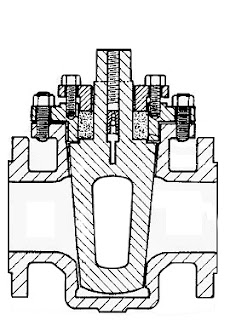 |
Plug valve diagram showing
plug shape and orifice. |
There are common components to be found on almost every process system that involves fluid control. Regardless of the operation's scale, pumps, piping, tanks and valves are likely to be part of the system.
Valves, of which there are many types, provide control over the flow rate, direction and routing of fluids in a processing operation. Flow can be started, stopped or modulated between zero and full rate using a properly sized and configured valve. Some valves enable media flow to be diverted to a selection of outlets, in lieu of a single inlet and outlet pair. Specialized valves regulate inlet or outlet pressure, or prevent fluid flow from going in an undesirable direction. All of these capabilities are packaged into differing valve product offerings that present a very large selection array to a process designer or engineer.
Industrial flow control valve types are generally classified according to the structure or arrangement contained within the valve body that provides obstruction to fluid flow. Some of the common types are ball, butterfly, gate, globe, and plug. Surely, there are more valve types, and this article is not intended to list them all. Some of our previous blogs have discussed selection considerations for gate, ball and butterfly valves. This article will focus on one of the oldest valve types, the
plug valve.
Plug valves, like ball and butterfly valves, span from fully open to fully closed positions with a shaft rotation of 90 degrees. The “plug” in a plug valve is installed in the flow path within the valve body and rotated by means of a stem or shaft extending to the exterior of the body. Plugs are often tapered toward the bottom and are fitted to a seating surface in the valve body cavity that prevents fluid from bypassing the plug. An opening through the plug, the port, can be shaped to provide particular flow characteristics. There are numerous variants of the basic plug valve which may make it suitable for particular applications. One common variant is the lined or sleeved plug valve, with an insert or interior lining of material that creates an isolating barrier between the valve body and the media. This allows use of less expensive materials for the body construction that may be otherwise subject to corrosion by exposure to aggressive media.
Plug valve advantages:
- 90 degree rotation from open to closed provides fast operation.
- With proper configuration, can be well suited for frequent operation.
- Availability of corrosion resistant liner may provide comparative cost savings because valve body can be constructed of less expensive material.
- Design is simple and employs a low parts count.
- Valve can be serviced in place.
- Generally, low resistance to flow when fully open.
- Reliable leak-tight service due to tapered plug wedging action, replaceable sleeve, and injection of lubricant in some variants.
Plug valve disadvantages:
- Higher friction in the plug closure mechanism may require comparatively higher operating torque than other valve types.
- Without a specially designed plug, generally not well suited for throttling applications.
- Rapid shutoff delivered by plug design may not be suitable for some applications where hammering may occur.
Share your fluid control application challenges with a
valve and automation specialist. Leverage your own knowledge and experience with their product application expertise to develop an effective solution.
Contact Thompson Equipment (TECO) for all your
valve automation and
valve repair needs.
https://teco-inc.com
800-528-8997







